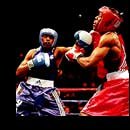Athletic success depends to a degree on fast-twitch/slow-twitch muscle fiber composition. Whether it be sprinting 100 meters in 9 seconds, running a marathon, or throwing a well timed punch in boxing to knock out ones opponent, we depend upon a certain percentage of each fiber type.

Depending on the type of sport, its concomitant duration, intensity and skill level, we will use a combination of both fast-twitch and slow-twitch fibers. However, one of these fiber types will usually predominate.
High intensity, anaerobic, short-burst activity, engages the fast-twitch fibers, which are lighter in coloring than slow-twitch fibers due to the low levels of myoglobin (the iron-containing protein found in muscle cells that stores oxygen for use in cell respiration) and mitochondria they possess.
Slow-twitch fibers, on the other hand, possess, not surprisingly, more mitochondria and myoglobin, and are red in coloring as a result. These fibers help to sustain one over a long activity period: a marathon or triathlon event for example.
The average person has about 50% slow and 50% fast fibers in most locomotory muscles. Those who dominate the athletic world, however, are blessed with muscle fiber composition variation compatible with their chosen sport. You can almost guarantee that 100-meter Olympic sprint champion Justin Gatlin has around 80% fast-twitch fibers in his quadriceps muscles.

How Do These Muscle-Fiber Types Work?

Essentially We Have Two Fiber Types:
- Fast-twitch (Type 2)
- Slow-twitch (Type 1)
The fast-twitch fibers, however, were re-classified due to observed differences in their properties. Fast-twitch fibers now have two subcategories: Fast-Glycolytic (FG) or Fast-Oxidative-Glycolytic (FOG), or 2b and 2a fibers respectively. FG fibers differ from FOG fibers in their pure fast-twitch properties.
They have few mitochondria and high levels of stored glycogen and the enzymes necessary for producing energy without oxygen. The FOG fibers have the stored glycogen and enzymatic properties of FG fibers, in addition to high levels of oxidative enzymes which assist aerobic metabolism. They have the best of both worlds.
Fast-twitch fibers exert their effects due to, as their name might suggest, peak-tension facilitation. A sprinter, for example, will reach phenomenal speeds due to the force production this peak-tension allows. It is worth noting here that fast-twitch fiber force production is no greater than slow-twitch fiber force production. The difference lies in the rate to which these fibers produce force.
Fast-twitch fibers allow one to generate a relatively high amount of force in a short period. The take-off motion in a sprint and long jump (when the foot is in contact with the ground for a millisecond) are perfect examples of this. Over a longer distance (whether it be cycling, running or rowing), fast-twitch fibers are useful primarily for their ability to activate during the sprint phase.
Slow-twitch fibers, on the other hand, come into play during the pure endurance aspect of these events. Fatigue resistance, at the expense of fast rate force production, is the hallmark of these fibers. A 2000-meter rowing race, or 26-mile marathon are instances where the slow-twitch fibers predominate.

To simplify things somewhat, a nice analogy can be used to explain the various actions of these two fiber types. Chickens, like us, have both fast- and slow-twitch fibers: their darker (red) meat is composed of slow-twitch fibers, and the white meat of fast-twitch fibers, in line with that of their human counterparts.
Chickens use their legs (red meat) for walking and standing for large periods of time, while their wings (white meat) are used for brief bursts of activity. This perfectly illustrates the compelling differences between fast- and slow-twitch fibers.
The process of contraction can also provide us with an example of fast-twitch/slow-twitch fiber engagement. Within a motor unit (a group of muscle fibers and the single motor nerve that activates the fibers) there can only be one type of muscle fiber. Therefore, when a group of muscles contract there is generally an activation of either slow- or fast-twitch fibers.
If the contraction is weak, the slow-twitch (type 1) fibers will take control. Conversely, when the contraction is maximal, the fast twitch (type 2b) fibers will predominate. If the contraction is only moderately stronger than our weak contraction, the fast-twitch type 2a fibers will activate.

Can We Alter Our Fast-Twitch/Slow-Twitch Composition?

Given that the exact composition of ones muscles is genetically determined, there is probably not a lot one can do to change the extent to which fiber types influence their training, during the early stages of their athletic career.
However, over time, purely fast twitch (Type 2b; FG) fibers can, it appears, transition to fast twitch with slow twitch properties (2a; FOG). This is great news for endurance athletes.
However, it will take years of chronic endurance training to achieve this. Indeed, biopsies of elite endurance athletes reveal that after years of training, they have almost no 2b fibers, but often have a significant percentage 2a fibers. It is further shown that type 2a fibers will not transition to type 1. This means that one who has fibers with a combination of fast-twitch/slow-twitch properties will be unable to change these to purely slow twitch.
So, it seems that by training intensely over long distances one can develop the mitochondria and surrounding capillaries of the muscle. More mitochondria and increased capillary density is the muscles attempt to minimize the cellular disturbance caused by the intensity of activity. This leads to an increased ability of the fiber to cope with successive training sessions.
However, in saying all of this, here are many more variables that dictate athletic success. Indeed, it has been said that fiber type composition, in the scheme of things, is a poor predictor of athletic performance. Hydration, mental state, nutrition and rest remain profoundly important indicators of success in the athletic sphere.
Below is a table depicting the characteristics of the three different sub-types of muscle fibers.
| Characteristic | Slow Twitch (1) | Fast Oxidative (2a) | Fast Glycolytic (2b) |
| Myosin ATPase activity: | Low | High | High |
| Speed of contraction: | Slow | Fast | Fast |
| Fatigue resistance: | High | Intermediate | Low |
| Oxidative capacity: | High | High | Low |
| Anaerobic enzyme content: | Low | Intermediate | High |
| Mitochondria: | Many | Many | Few |
| Capillaries: | Many | Many | Few |
| Myoglobin content: | Low | Low | High |
| Color of fiber: | Red | Red | White |
| Glycogen content: | Low | Intermediate | High |
| Fiber diameter: | Small | Intermediate | Large |

Conclusion

As shown, athletic success may depend largely on ones muscle fiber composition. With the greatest sprinters requiring a large number of fast-twitch fibers and marathoners needing a predominance of slow-twitch fibers, it is clear that athletes are blessed with the genetic goods to dominate in their respective sports.
However, although fiber types are probably very important, diet, training type, mental attitude and rest are ultimately deciding factors.
References
